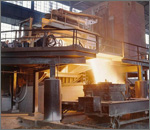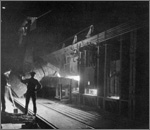Introduction: Open hearth furnace is the oldest method of melting pig iron to produce steel. Steel, which has a high melting point, cannot be melt using the commonly used fu

rnace. Using the regenerative firing method, upto 1600°C of heat can be produced that is required melting pig Iron for steel.
History : The first open hearth furnace might have been used in the 8th century A.D. but the first commercial use for steelmaking was done in the 19th Century. A well known and widely used process Siemen Regenerative Furnace was developed around 1850 by Sir Wilhelm Siemens. Operating at high temperature this process can save nearly 80% of the fuel by using regenerative preheating for fuel. However, the process failed because the lining of the furnace also melted.
Later a French father and son engineers Pierre-Emille Martin took out a license from Siemens. They modified it and named the process regenerative process and the furnace as an “open-hearth” furnace. Martins developed a furnace with wall lining that were heat resistant. The process which is known as siemen-martins process began in 1864. For 100 years, siemen-martins process and open hearth furnace ruled the steel making industry. In the 20th century however the process was replaced by more effective methods like the electric arc furnace and converter
Open Hearth Melting Process(Siemens Process): The Siemens-Martin open hearth furnace consists of upper and lower furnace. The top furnace is to melt the metal and the lower furnace is the regenerative chamber where the combustion air and the generator gas are preheated. In this process, exhaust gases from the furnace are pumped into a chamber containing bricks, where heat is transferred from the gases to the bricks. The flow of the furnace is then reversed so that fuel and air pass through the chamber and are heated by the bricks. Through this process the temperature reaches upto 1800°C, which is high enough to melt steel.

In order to remove the elements or impurities like carbons, manganese, silicon, phosphorus and other elements, either the substances are oxidized and escape as gas or float on the liquid steel.
Open Hearth Furnace Application: The usual size of furnaces is 50 to 100 tons, but for some special processes they may have a capacity of 250 or even 500 tons. Many nations including U.S. have stopped using open hearth. Nearly half of the steel produced using open hearth furnaces remains Ukraine.
Advantages of Open Hearth Furnace:This process is economical because by using regenerative firing heat is produced with less fuel consumption.
Unlike conventional furnace, here temperature of the furnace can be increased up to 1800°C and nearly 600 tons of steel can be produced.


